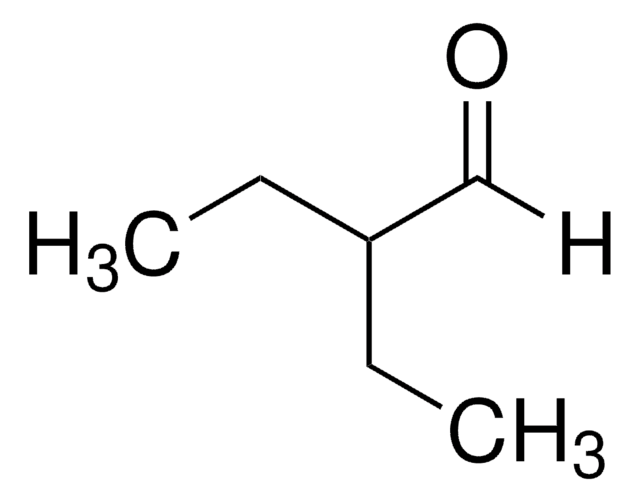W269107
2-Methylbutyraldehyde
≥95%, FG
Sinonimo/i:
2-Methylbutanal
About This Item
Prodotti consigliati
Origine biologica
synthetic
Livello qualitativo
Grado
FG
Fragrance grade
Halal
Kosher
agenzia
(EU Regulation 1223/2009)
(follows IFRA guidelines)
Conformità normativa
EU Regulation 1334/2008 & 178/2002
FDA 21 CFR 117
FDA 21 CFR 172.515
Saggio
≥95%
Impurezze
<5% isopentanal
Indice di rifrazione
n20/D 1.3919 (lit.)
P. eboll.
90-92 °C (lit.)
Densità
0.806 g/mL at 20 °C
0.804 g/mL at 25 °C (lit.)
applicazioni
flavors and fragrances
Documentazione
see Safety & Documentation for available documents
Allergene alimentare
no known allergens
Allergene in fragranze
no known allergens
Organolettico
chocolate; coffee
Stringa SMILE
[H]C(=O)C(C)CC
InChI
1S/C5H10O/c1-3-5(2)4-6/h4-5H,3H2,1-2H3
BYGQBDHUGHBGMD-UHFFFAOYSA-N
Cerchi prodotti simili? Visita Guida al confronto tra prodotti
Categorie correlate
Descrizione generale
Applicazioni
- In Staphylococcus aureus, the acyl-CoA synthetase MbcS supports branched-chain fatty acid synthesis from carboxylic acid and aldehyde precursors.: This study explores the role of the enzyme MbcS in Staphylococcus aureus, demonstrating how it utilizes 2-Methylbutyraldehyde as a precursor in the synthesis of branched-chain fatty acids, which are essential for bacterial growth and virulence (Dos Santos Ferreira et al., 2024).
- Volatile Short-Chain Aliphatic Aldehydes Act as Taste Modulators through the Orally Expressed Calcium-Sensing Receptor CaSR.: This study investigates how volatile short-chain aldehydes, including 2-Methylbutyraldehyde, modulate taste perception through the calcium-sensing receptor CaSR, providing insights into their potential applications in food and flavor industries (Kitajima et al., 2023).
Avvertenze
Danger
Indicazioni di pericolo
Consigli di prudenza
Classi di pericolo
Aquatic Chronic 2 - Eye Irrit. 2 - Flam. Liq. 2 - Skin Sens. 1 - STOT SE 3
Organi bersaglio
Respiratory system
Codice della classe di stoccaggio
3 - Flammable liquids
Classe di pericolosità dell'acqua (WGK)
WGK 2
Punto d’infiammabilità (°F)
23.0 °F
Punto d’infiammabilità (°C)
-5 °C
Dispositivi di protezione individuale
Eyeshields, Faceshields, Gloves, type ABEK (EN14387) respirator filter
Certificati d'analisi (COA)
Cerca il Certificati d'analisi (COA) digitando il numero di lotto/batch corrispondente. I numeri di lotto o di batch sono stampati sull'etichetta dei prodotti dopo la parola ‘Lotto’ o ‘Batch’.
Possiedi già questo prodotto?
I documenti relativi ai prodotti acquistati recentemente sono disponibili nell’Archivio dei documenti.
I clienti hanno visto anche
Il team dei nostri ricercatori vanta grande esperienza in tutte le aree della ricerca quali Life Science, scienza dei materiali, sintesi chimica, cromatografia, discipline analitiche, ecc..
Contatta l'Assistenza Tecnica.













